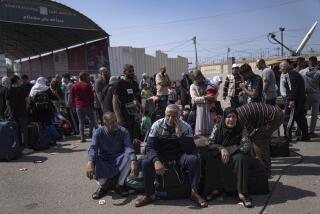U.S.-Russian Efforts to Protect Arsenal Gain Steam
Joint U.S.-Russian efforts to boost security against potential terrorist attacks on Russian storage sites for nuclear warheads have accelerated in recent months, the chairman of the Senate Foreign Relations Committee said here Friday.
Sen. Richard G. Lugar (R-Ind.) credited the stepped-up pace of activity to a new commitment by Russian President Vladimir V. Putin after a February summit with President Bush in Bratislava, Slovakia.
“We’ve had an agreement for inspections at the warhead storage sites that has broken the logjam of misunderstanding there,” Lugar said at a news conference. “This is an important breakthrough.”
Under the 1991 Nunn-Lugar Act, which established the Cooperative Threat Reduction program, the United States has spent billions of dollars to help dismantle nuclear warheads, ballistic missiles, bombers, submarines and other weapons in former Soviet states.
But joint efforts to prevent terrorists from raiding Russian storage facilities and obtaining nuclear weapons largely have faltered. The U.S. sought to monitor how its funds would be used to upgrade security, something Russia had been unwilling to allow, Lugar said at the news conference and in a subsequent interview.
In June, however, Russia presented the United States with a list of 25 to 30 nuclear warhead storage sites and said that three U.S. inspections would be allowed at each, Lugar said.
“Terrorists have become tougher,” Lugar said. “This is a Russian-American response to toughen the targets too. We’re not asleep either.”
Lugar said that until the February summit, “things were ... certainly not going very fast in this area.”
“I think that President Bush and President Putin, taking a look at the war on terror -- and this is the point we’re making anecdotally about how terrorists sometimes are becoming more proficient in their craft -- I think the two presidents recognized we needed to upgrade so we were more proficient in our protection,” Lugar said.
“The Russians in the past had placed severe limitations upon inspection of the storage sites, so this was an important breakthrough,” he added. “The Russians in essence are saying, ‘Your privileges to inspect are not unlimited, but at least you have three opportunities.’ ”
Lugar is in Russia with Sen. Barack Obama (D-Ill.) to visit several sites associated with the program. They are scheduled to visit a nuclear warhead storage facility in Saratov, 450 miles south of Moscow, and a site near Perm, about 725 miles east of the Russian capital, where mobile SS-24 and SS-25 intercontinental ballistic missiles that once threatened the United States are being destroyed.
On previous visits, Lugar said, he has run into situations where Americans were denied access to U.S.-funded activities.
“There might be a commander who is just uncooperative, who wasn’t really eager to see Americans around there,” Lugar said. “So we had to argue diplomatically that, after all, this was cooperative, we were providing contractors and various other support, so we felt that for the American taxpayers we ought to take a look. This was not always agreed to in the old days or more recent days.”
Lugar recalled visiting a Russian warhead storage facility about five years ago.
“Literally we saw the warheads sort of like coffins, lying side by side, with labels at the top indicating ... when the warhead was constructed, what kind of servicing, how long it might have efficacy,” he said.
Lugar said he believed it was important for the momentum of the program to continue the work, citing as an example U.S. help in construction of a plant in the Siberian town of Shchuchye to destroy chemical weapons.
“We believe it’s in our best interests to continue to work with the Russians and other countries to fund the Shchuchye project, which I understand will finally be completed in about 2008, because there’s still 40,000 metric tons of nerve gas or other dangerous chemical weapons out there that Russia has pledged to destroy but physically found it’s unable to do so by itself,” he said.
On Friday, Lugar and Obama visited a Moscow-area agricultural laboratory where Soviet-era research included finding ways to counter a possible U.S. biological weapons attack.
“This is a biological facility dealing with agricultural situations, and there are dangerous pathogens. They’re scattered over many rooms, many floors, many buildings,” Lugar said. “So the idea, which the Russians fully support and are enthusiastic about, is that we rebuild a certain section or fortify these rooms so they will contain in a fairly small area the pathogens, and thus secure the place.”
More to Read
Start your day right
Sign up for Essential California for news, features and recommendations from the L.A. Times and beyond in your inbox six days a week.
You may occasionally receive promotional content from the Los Angeles Times.






